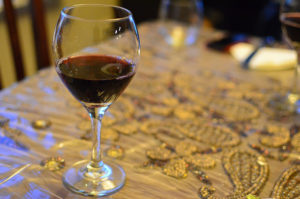The concept of wine (particularly red wine) being healthy for you is not a new phenomenon. While we’ve certainly seen stories of wine’s purported health benefits on a somewhat regular basis over the last few decades, the idea of wine as being good for you can be traced all the way back to ancient Greece and Rome.

Photo courtesy Flickr user akash.mehra
Red wine, particularly the compound resveratrol, has been the focus of a lot of research related to health, with benefits found ranging from lowering cardiovascular disease risk to improving lifespan and decreasing the risk of certain cancers. Some research suggests that the amount of wine one would have to drink in order to consume enough resveratrol to see actual health benefits would be very harmful, while others disagree, in that perhaps resveratrol working in concert with other compounds in the wine to improve one’s health at much lower volumes.
With the results of these studies frequently in our faces, it’s become common for people to believe that wine is healthy for you. Understanding how consumers perceive the reported health benefits of wine could be very useful for marketers, for knowing this information might help better target campaigns toward specific groups of people.
A new study, currently in press and available online since September in the journal Wine Economics and Policy, aimed to look into the concept of perceived health benefits of wine further, by examining how gender, age, and race/ethnicity might influence these perceptions.
Brief Methods
In order to examine how perceived health benefits differ (or are similar) between different demographics, an online survey approach was utilized.
The researchers used definitions set by the Wine Market Council in 2015 to identify the different generations: Millennials (ages 23-37), Gen X (ages 38-49), Boomers (ages 50-68), Swing (ages 69-81), and WWII (ages 82+). Millennials were further subcategorized as “Old Millennials” (ouch. In their 30s) and “Young Millennials” (in their 20s), since spending habits differ between the two, as well as wine consumption habits (Old Millennials drink more wine).
Definitions set by the U.S. Census were used to identify the different ethnicities: White/non-Hispanic, Hispanic, Asian, African American, and Native Americans/Pacific Islanders/Mixed.
See Table 1 for a breakdown of general U.S. demographics, as well as demographics specific to wine consumers, as reported by the U.S. Census and the Wine Market Council (2015), respectively.
To determine how consumers view health issues in general, the researchers adapted the Gould’s Health Conscious Scale, which has been utilized by countless studies since 1988. Additionally, questions about health and how it relates to wine were also included.
For the study participants, the researchers actively recruited enough people to have a representative sample of US wine consumers.
In total, there were a total of 1,054 completed surveys for gender, 1,055 for generation, and 1,028 for ethnicity.
Selected Results
- 41% of participants were men, and 59% were women.
- 27% of participants were Young Millennials, 29% Old Millennials, 23% Gen X, and 21% Boomers.
- There were not enough participants in the oldest Swing and WWII generations, so those data were not included in analysis.
- 65% of participants were White/non-Hispanic, 13% were Hispanic, 11% were Asian, and 11% were African American.
- Men were more concerned about their health status than women.
- Men and women were equally aware of any changes to their health.
- Millennials were more concerned about their health than Gen X and Baby Boomers.
- African Americans and Asians were more concerned about their health than Whites and Hispanics, with Whites being the least health conscious of all ethnicities.
- 80% of all participants agreed that wine is healthier than beer or spirits (3.6% disagreed, and I assume that means the rest were neutral).
- There were no differences in any of the age, gender, or ethnic groups.
- Half of the participants believed that sulfites were responsible for headaches (10-16% disagreed).
- Women were more likely to believe sulfites causes headaches than men.
- 85% of participants agreed that red wine was the healthiest type of wine, followed by white wine, rosé, sparkling wine, and finally fortified wine.
- 20% of African Americans considered sparkling wine a healthier type of wine, compared to only 8% of whites.
Conclusions
Overall, the results of this study indicate that while most everyone seems to believe that wine is healthy, there are differences between age, gender, and ethnicity when it comes to specific issues related to wine and health. Specifically, the researchers highlighted five main findings that could be used to help better target ad campaigns:
- Millennials were the most concerned about their health.
- Asians were the most health conscious group.
- Wine is perceived to be healthier than beer and spirits across all ages, genders, and ethnicities.
- About 50% of participants believed sulfites in wine cause headaches.
- More African Americans perceived sparkling wine as healthy compared with all other ethnicities.
In general, wine is universally considered healthy across all demographics in this study, while health concerns in general differ from group to group. In terms of ad campaigns, explicitly stating the wine is “good for you” is limited by the TTB, though if a winery were to decide to play the health card to help sell their wines, doing it in a face-to-face scenario (like in the tasting room) might be fair game, though I’m not certain of the legality of that as well.

Photo courtesy Flickr user Jing
The most important result, in my opinion, was the finding that around 50% of participants believed sulfites in wine cause headaches. For those of us in the industry, we are well aware that this statement is inaccurate, though somehow there are still a significant number of people who believe that it is true. It is important for wine educators to help spread the truth about sulfites in wine, so that this misconception does not continue to persist in the market.
The study itself did have some limitations, with the biggest probably being the non-random nature of sampling. Specifically, the participants were not a random sample, but were, in fact, selected specifically to fit a predetermined mold (i.e. to be as close to the demographics of the US wine consumer population as possible). Because of this, the results of the study should be taken with a grain of salt. A truly random selection of participants in much larger numbers would likely be more representative of the population as a whole compared to a specific group of participants basically “hand-picked” for the study.
Source:


2 comments for “The Perception of Wine As a Healthy Beverage: A Study of US Demographics”